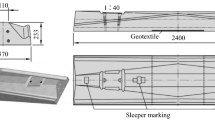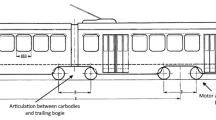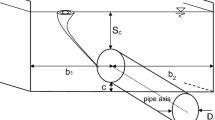Abstract
Inspired by the fact that bogies and bottom equipment generally contribute a great deal of aerodynamic drag to high-speed trains, this paper puts forward a simple method of mounting some small deflectors before and/or after the bogie cabins to optimize the underbody flow and reduce the aerodynamic drag of high-speed trains. The flow fields of the high-speed train models with and without bottom deflectors are numerically studied by the IDDES method. The effectiveness and further mechanism of the bottom deflectors on aerodynamic drag reduction are analyzed. It is demonstrated that the bottom deflectors could guide the underbody flow to the ground and prevent it from hitting on the bogies and bottom equipment of the train, resulting in a significant aerodynamic drag reduction effect. Moreover, the effects of different mounting locations of bottom deflectors on drag reduction are discussed as well, and an optimal mounting configuration with a drag reduction effect of up to about 12% is finally obtained. Nevertheless, the mounted deflector is also proved capable of significantly reducing the interference range of the underbody flow and reducing the slipstream of the train, which possesses a higher guarantee for the safety of railway workers and passengers waiting on the platforms. This work provides a new idea for aerodynamic drag reduction of high-speed trains, and is of great significance in energy conservation and consumption reduction.
摘要
转向架和车下设备区域是高速列车气动阻力的主要来源之一. 基于此, 本文提出一种安装于转向架舱前后端的小型导流板装置, 以改善列车的底部流动、减小列车的气动阻力. 采用IDDES方法对是否安装底部导流板的不同列车模型开展非定常数值仿真, 并对导流板的减阻效果和作用机理进行分析. 结果表明: 底部导流板可以将列车底部高速气流导向地面, 减小气流对转向架及车下设备的冲击作用, 从而产生显著的气动减阻效果. 此外, 还讨论了底部导流板不同安装位置对减阻效果的影响, 最终得到了实现整车减阻约12%的一种最佳安装方式. 同时, 导流板还能够减小底部流场在展向上的影响范围, 减小列车风, 这对铁路沿线工人和平台等候乘客的安全具有更高保障. 本研究为高速列车气动减阻提供了新思路、 新方法, 对节能减耗、可持续发展等具有重要意义.
Similar content being viewed by others
References
R. S. Raghunathan, H. D. Kim, and T. Setoguchi, Aerodynamics of high-speed railway train, Prog. Aerosp. Sci. 38, 469 (2002).
M. Yang, J. Du, Z. Li, S. Huang, and D. Zhou, Moving model test of high-speed train aerodynamic drag based on stagnation pressure measurements, Plos One 12, e0169471 (2017).
S. S. Ding, Q. Li, A. Q. Tian, J. Du, and J. L. Liu, Aerodynamic design on high-speed trains, Acta Mech. Sin. 32, 215 (2016).
T. Maeda, T. Matsumura, M. Iida, K. Nakatani, and K. Uchida, in Effect of shape of train nose on compression wave generated by train entering tunnel: Proceedings of the International Conference on Speedup Technology for Railway and Maglev Vehicles, Yokohama, 1993, pp. 315–319.
X. Li, G. Chen, D. Zhou, and Z. Chen, Impact of different nose lengths on flow-field structure around a high-speed train, Appl. Sci. 9, 4573 (2019).
J. T. Du, A. Q. Tian, S. S. Nie, H. K. Li, and T. H. Liu, Research on the mapping relations between the drag and lift properties and the shape parameters of a high-speed train (in Chinese). J. Railw. Sci. Eng. 13, 1017 (2016).
S. Yao, D. Guo, Z. Sun, G. Yang, and D. Chen, Optimization design for aerodynamic elements of high speed trains, Comput. Fluids 95, 56 (2014).
G. Xu, X. Liang, S. Yao, D. Chen, and Z. Li, Multi-objective aerodynamic optimization of the streamlined shape of high-speed trains based on the Kriging model, Plos One 12, e0170803 (2017).
L. Tian, L. Ren, Q. Liu, Z. Han, and X. Jiang, The mechanism of drag reduction around bodies of revolution using bionic non-smooth surfaces, J. Bionic. Eng. 4, 109 (2007).
P. P. Sun, Research on aerodynamic drag reduction of high-speed train with non-smooth surface (in Chinese), Dissertation for the Master’s Degree, (Zhejiang University, Hangzhou, 2012).
K. Tang, S. W. Ma, H. Q. Liang, and G. F. Ding, Simulation research of the drag reduction of high-speed train microstructured surfaces (in Chinese). Mach. Des&. Manuf. 9, 213 (2020).
M. Y. Wang, S. A. Hashmi, Z. X. Sun, D. L. Guo, G. Vita, G. W. Yang, and H. Hemida, Effect of surface roughness on the aerodynamics of a high-speed train subjected to crosswinds, Acta Mech. Sin. 37, 1090 (2021).
V. V. Pavlov, Dolphin skin as a natural anisotropic compliant wall, Bioinspir. Biomim. 1, 31 (2006).
J. Wang, S. S. Koley, and J. Katz, On the interaction of a compliant wall with a turbulent boundary layer, J. Fluid Mech. 899, A20 (2020).
E. O. Shkvar, A. Jamea, S. J. E, J. C. Cai, and A. S. Kryzhanovskyi, Effectiveness of blowing for improving the high-speed trains aerodynamics, Thermophys. Aeromech. 25, 675 (2018).
R. Nolte, and F. Wurtenberger, Event evaluation of energy efficiency technologies for rolling stock and train operation of railways, International Union of Railways. Deutsche Bahn AG, Berlin, 2003.
M. Suzuki, K. Nakade, and A. Ido, Countermeasures for reducing unsteady aerodynamic force acting on high-speed train in tunnel by use of modifications of train shapes, JMTL 2, 1 (2009).
G. Mancini, A. Malfatti, A. G. Violi, and G. Matschke, in Effects of experimental bogie fairings on the aerodynamic drag of the ETR 500 high speed train: Proceedings of the World Congress on Railway Research, Cologne, 2001.
J. Wang, G. Minelli, Y. Zhang, J. Zhang, S. Krajnović, and G. Gao, An improved delayed detached eddy simulation study of the bogie cavity length effects on the aerodynamic performance of a high-speed train, Proc. Institution Mech. Engineers Part C-J. Mech. Eng. Sci. 234, 2386 (2020).
W. Liu, D. Guo, Z. Zhang, D. Chen, and G. Yang, Effects of bogies on the wake flow of a high-speed train, Appl. Sci. 9, 759 (2019).
J. Zhang, J. Wang, Q. Wang, X. Xiong, and G. Gao, A study of the influence of bogie cut outs’ angles on the aerodynamic performance of a high-speed train, J. Wind Eng. Industrial AeroDyn. 175, 153 (2018).
G. J. Gao, Q. R. Chen, J. Zhang, Y. Zhang, Z. Tian, and J. Chen, Numerical study on the anti-snow performance of deflectors on a high-speed train bogie frame, J. Appl. Fluid Mech. 13, 1377 (2020).
J. Niu, D. Zhou, and X. Liang, Numerical simulation of the effects of obstacle deflectors on the aerodynamic performance of stationary high-speed trains at two yaw angles, Proc. Inst. Mech. Eng. Part F-J. Rail Rapid Transit. 232, 913 (2018).
Z. Guo, T. Liu, Z. Chen, Y. Xia, W. Li, and L. Li, Aerodynamic influences of bogie’s geometric complexity on high-speed trains under crosswind, J. Wind Eng. Ind. Aerodyn. 196, 104053 (2020).
S. B. Yao, Z. X. Sun, D. L. Guo, D. W. Chen, and G. W. Yang, Numerical study on wake characteristics of high-speed trains, Acta Mech. Sin. 29, 811 (2013).
T. W. Muld, G. Efraimsson, and D. S. Henningson, Flow structures around a high-speed train extracted using proper orthogonal decomposition and dynamic mode decomposition, Comput. Fluids 57, 87 (2012).
Z. Guo, T. Liu, H. Hemida, Z. Chen, and H. Liu, Numerical simulation of the aerodynamic characteristics of double unit train, Eng. Appl. Comput. Fluid Mech. 14, 910 (2020).
STAR-CCM+ v9.06 User’s Manual. CD-adapco Co., 2014.
S. Wang, J. R. Bell, D. Burton, A. H. Herbst, J. Sheridan, and M. C. Thompson, The performance of different turbulence models (URANS, SAS and DES) for predicting high-speed train slipstream, J. Wind Eng. Ind. Aerodyn. 165, 46 (2017).
Z. X. Xiao, and K. Y. Luo, Improved delayed detached-eddy simulation of massive separation around triple cylinders, Acta Mech. Sin. 31, 799 (2015).
C. Xia, H. Wang, X. Shan, Z. Yang, and Q. Li, Effects of ground configurations on the slipstream and near wake of a high-speed train, J. Wind Eng. Industrial AeroDyn. 168, 177 (2017).
J. Wang, G. Minelli, X. Miao, J. Zhang, T. Wang, G. Gao, and S. Krajnović, The effect of bogie positions on the aerodynamic behavior of a high-speed train. An IDDES study, Flow Turbul. Combust. 107, 257 (2021).
Wind tunnel test report for a new generation of high-speed trains. CRRC Qingdao Sifang Co., Ltd., 2009.
C. Xia, X. Z. Shan, and Z. G. Yang, Comparison of different ground simulation systems on the flow around a high-speed train, J. Rail& Rapid Transit. 231, 135 (2017).
C. Baker, The flow around high speed trains, J. Wind Eng. Ind. Aerodyn. 98, 277 (2010).
Author information
Authors and Affiliations
Corresponding author
Additional information
This work was supported by the National Key Research & Development Projects (Grant No. 2017YFB0202801), the Strategic Priority Research Program of the Chinese Academy of Sciences (class B) (Grant No. XDB22020000), and Research project of Chinese Academy of Sciences (Grant No. XXH13506-204).
Rights and permissions
About this article
Cite this article
Liu, W., Ji, Z., Guo, D. et al. Effects of bottom deflectors on aerodynamic drag reduction of a high-speed train. Acta Mech. Sin. 38, 321251 (2022). https://doi.org/10.1007/s10409-021-09058-x
Received:
Accepted:
Published:
DOI: https://doi.org/10.1007/s10409-021-09058-x




